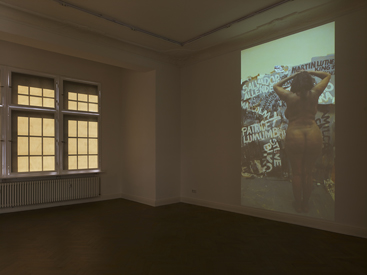
Born in Durban (ZA). Lives and works in Durban (ZA).

2012
Video, colour, stereo sound
durée: 13'
Year of Purchase: 2013
Tracey Rose is a South-African artist born in Durban, a town where she settled back after a period of absence. She studied art at the University of Witwatersrand in Johannesburg, and quickly gained international recognition for her performances, video installations, and photography.
Tracey Rose’s works are violent, mystical, and infallibly tied up with reality. They are violent because the world is violent, and so is human history; this is not a matter of choice. Her work is performative, involving video and photography, almost invariably drawing on the body or bodies. The body is something that does not lie, but carries the genealogical weight of an atrocious past. This past deforms, transforms, and haunts the body, makes it howl, swell, as well as dance. Tracey Rose’s work is a historic trance, a ceremony of perpetual commemoration, a contestation of oblivion, and hatred of the famed resilience. The artist’s mind and body are always open to possession: does she summon it or submit to it? Her work needs to be understood as the history of every domination, of every submission, of every murder, of every racialized body, and of every rape. It is, of course, a history of Apartheid, but also other histories, both more ancient and more modern. In The Black Paintings: Dead White Man, a 13-minute-long video, one first distinguishes an agonizing, guttural sound emitted by the artist. This sound blends in with a recitation of the names of the dead: famous victims, perhaps political martyrs. Then comes the word “white” repeated until the artist is out of breath. And the loop starts over. What do we see? First, a place of worship, an altar of painted cardboard once again spelling out the names. Then a priestess enters, a pagan, demonic priestess: she turns her back to us; her body is grey, brown, painted, muddy. She is ironically Adamic. A dance begins that could be either a lamentation or an exorcism. Toward the end, the priestess turns around, facing us, and we can see that she is carrying life. This body turned away from us also represents the memory, deeply rooted in Rose’s work, of Saartjie Baartman (see Venus Baartman, 2001), nicknamed the Black Venus or the Hottentot Venus, with whom the artist shares Khoi ancestry. Rose’s wrath feeds on this memory of Baartman in her cage and of the return of her remains from France to South Africa in 2002, memory which swells the artist’s body to bring Baartman back to life.
Lucie’s Fur Version: Adam and Yves is the oldest photograph by Tracey Rose, belonging to an extensive series. At the time of its creation, Rose worked on the mythology surrounding the origins of humanity: she was looking for evidence against, and for ways of subverting, religious dogmas, scientific theories of evolution, and art-historical conventions. The title of the work refers to the fossil, nicknamed “Lucy,” of the extinct species Australopithecus Afarensis discovered at the site of Hadar in Ethiopia in 1974. It was the much-debated question of Lucy’s place in human evolution that compelled Rose to create African allegories in the series Lucie’s Fur, which work to undo racial typologies and Biblical imagery. Rose thus rereads the story of Annunciation through several photographs and, with Adam and Yves, offers an image of the forefathers of the species that rejects the supposed, and forcibly imposed, universal wisdom of the nuclear family.
Eva Barois de Caevel